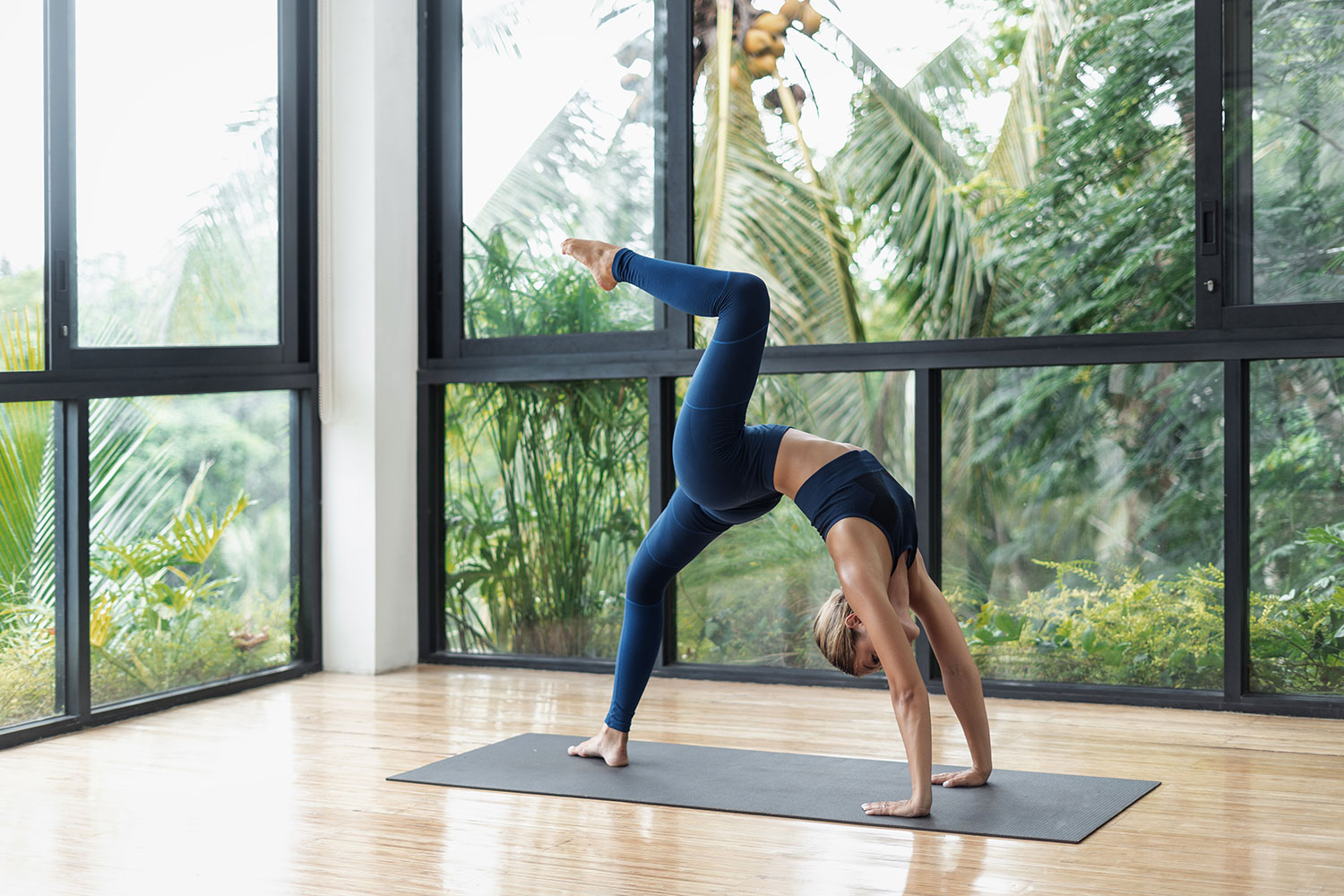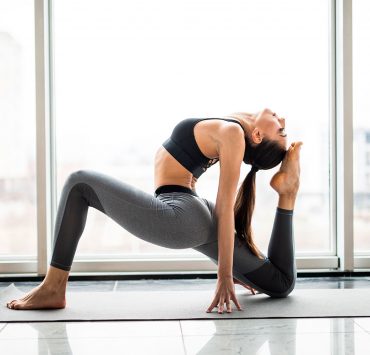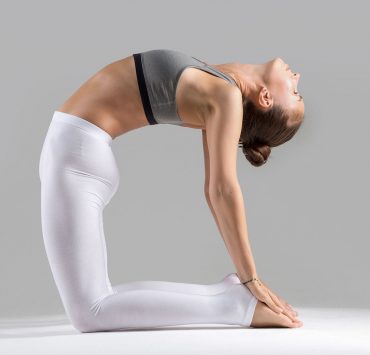
Having been a teacher’s assistant at over 50 yoga teacher…
When thinking about a daily practice, consider which poses you like doing and which ones you are working on. Are you trying to master a handstand, or working yourself into a bow pose? Try to add these into your yoga flow. Which poses do you feel safe and comfortable in? Even the most familiar poses teach us something new. A nice combination of poses you’ve mastered with poses you’d like to do better in varies your practice and helps you to become a more flexible yogi. Yoga practice can be thought about in the type of forms or the muscle groups you’re working on. Achieving balance in your practice should be a goal as well as physical balance. A daily yoga practice can support well being on many different levels. Develop yourself as a yogi by varying your routine and creating a solid routine that works through the different elements.
Seated Postures

Beginning your practice in a seated padmasana giving thanks to the day and for everything that you are grateful for is a grounded way to start. Sitting in meditation is, to some yoga practitioners, a crucial aspect of the practice. When doing padmasana, alternate the position of the feet for the most benefit. Hold it for two minutes or longer. Whichever other seated poses call to you in the moment, you can try. Some favorites are seated twist or the butterfly pose.
Forward Bend

The next motion in this series would be a forward bend. This helps to regulate the breathing and provides gentle blood flow to the head and upper body to prepare mentally and physically for more challenging poses. Forward bends stretch the spine and help to further ground the energy through the hands. Padangusthasana is an excellent example of a forward pose. Either put your hands on the ground or hold your elbows and gently swing your arms. Other common forward bends involve spreading the legs out and pressing your hands to the ground.
Glutes

One pose that strengthens the glutes is Warrior 1 or Warrior 2 These poses stretch your core muscles, arms and builds strength in lower part of the body. Other great poses that work this area are lunges, chair pose, goddess pose and garland pose (malasana). Holding these poses and breathing into them while engaging the muscles builds strength in the legs and glutes. Pigeon pose is another way to exercise the glutes. The most important part on working on this muscle group is to engage it by flexing and strengthening the muscles. Focusing your energy on this group while performing the post helps to stabilize your performance and will enhance your entire workout.
Core

The core is our foundation that holds our organs and where all the limbs and neck extend. Focusing on strengthening the core helps in every other aspect of yoga and life. Boat pose is one that focuses on all of the core muscles. Try to hold this pose for 2 or 3 minutes. Another core pose is cat/cow flow. This builds on the inner muscles and flowing the diaphragm. When you are doing any pose, visualize the muscles lengthening and really feel the stretch. You can also engage the muscles as well. Any pose can be enhanced by tightening and engaging the abdominal area. This is the key to building strong abs is by actively working on them while you are performing the pose, otherwise other muscle groups can
Leg Balance

Balancing on one leg is a skill that is easy for some or challenging for others. Practicing balancing while standing helps you to achieve balance in other areas of your life, physically, emotionally and spiritually. You can work up to balancing if it isn’t a skill that you naturally acquired. The main barrier to leg balancing is in the mind as, barring physical handicaps, it is something that everyone can easily do. The beginning balance pose is tree pose. Stand on each leg for 2 minutes, with your hands pressed together in prayer pose in front of your chest. Another leg balance is the three legged dog pose, standing split or half moon pose and dancer’s pose. These lengthen the body and strengthen the core as well as incorporating a solid forward bend.
Strength

One essential strength building pose is the plank. Building from a minute on your palms to a minute on your elbows helps emphasize core muscles and the shoulders. Other plank variations are side plank that will build strength. Another is the chaturanga. Consciously lowering yourself to the ground and holding your body with your elbows to the side works out the muscles, core and back muscles. Chair pose held for a long period of time will also build strength.
Backbends

Flexing your spine and working on the energy flow there is crucial for a healthy yoga practice. A nice beginner backbend exercise is the camel pose. If you’re up for it, the wheel pose is the hallmark back bend. The bow pose helps you build up to the wheel pose. Newbies to backbends should slowly stretch out and test the waters before committing to the full backbend. Don’t be afraid to use props like blocks or straps to help you get accustomed to backbends. Another great backbend is the royal pigeon pose or the mermaid pose.
Inversions

Inversions are when you are upside down on your hands. These stimulate the blood flow and are a great way to boost your mood. Looking at life from a different perspective helps you to gain detachment in other areas of your life and the ability to think about things in a different way. A daily shoulder stand is shown to have great benefits for the digestive system and lungs. Shoulder stands are known as the king of yoga poses and it is one of the first inversions that most people can successfully attempt. Other inversions are headstands. Support your head and neck in a tripod, and practice against a wall or with a friend if you’re new to inversions. Other inversions are the handstand and more advanced postures like scorpion pose.
Arm balances

Arm balances take skill and concentration, but are an essential tool in becoming a yogi adept. A more advanced but still beginner pose is dolphin pose. This puts the body’s weight on the elbows while standing. It’s a great strength. The first arm balance most yogis learn is the crow pose. There are a few variations on this that work on different muscle groups and can be a fun challenge. Other simple arm balances is the scales pose, which begins in a seated padmasana and puts weight on the hands. More advanced arm balances are the peacock pose or chin stand.
Legs up the wall

Using the wall as a prop is a standard yin yoga practice. This pose is best at the end of the day to help stretch the legs and bring the body into relaxation. This helps relax the heart and steadies the breathing. You can extend the arms out or rest them on the body. If you need blocks, you can place them under your hips for a gentle stretch. This pose also helps you to quiet your mind. Legs up the wall is a good stretch and it is a very grounding and centering practice to incorporate into your yoga.
A daily yoga practice is a great opportunity to connect with your body and go inward. Beginner yogis who want to transition from following an instructor to developing their own practice will benefit from having a good mix of poses. This list works through the different elements and body groups for a solid practice that will stretch and engage all of your essential muscles. These daily poses are a starting point meant to inspire you and educate you about the different levels of asana to work through in your practice. Having a mix of poses you’re comfortable with and poses that are new can help you to become a stronger person and more flexible in your daily routine. Working all areas of your body can balance your energy and chakras, so this list works through the 5 areas and focuses on what would help you to be stronger in your practice.
Resting pose

Every yoga practice should include a moment of repose. You might have a favorite resting pose, so incorporate that into your flow for a feeling of calm and balance. A simple child’s pose to surrender to the practice and let energy flow out is a good practice. Another good resting pose is shavasana, where you let the energy of the practice flow through you and ground. Some of the most heart opening moments are at the end of practice, thinking about the pose and resting. Happy baby pose is a healing pose that can help bring joy and flexibility into your life and practice.

What's Your Reaction?
Having been a teacher’s assistant at over 50 yoga teacher trainings worldwide, Rebecca Rebecca has a firm grasp on the fine art of yoga and meditation. In her work, she carefully reflects on a vast expanse of knowledge to help others find peace in both body and mind.














